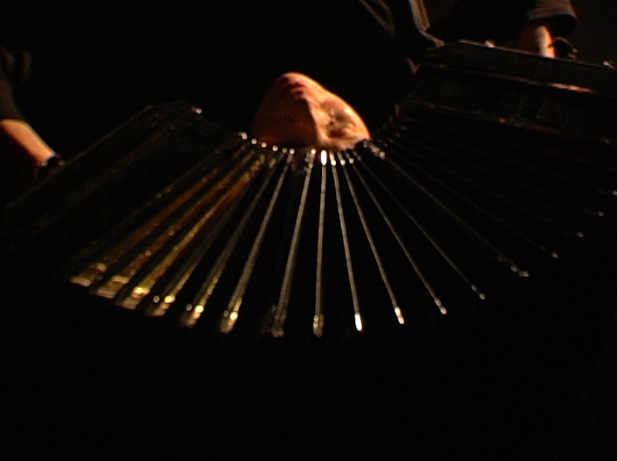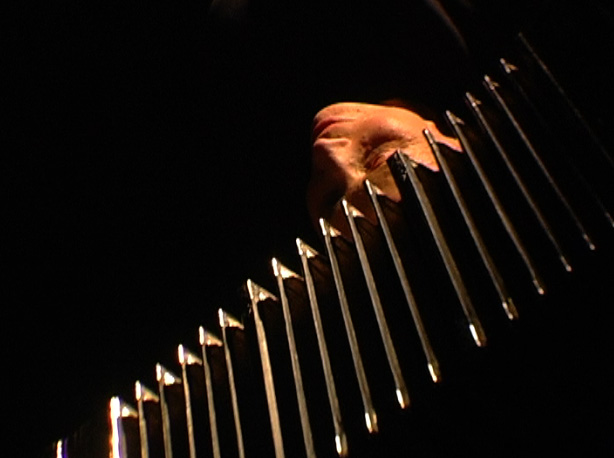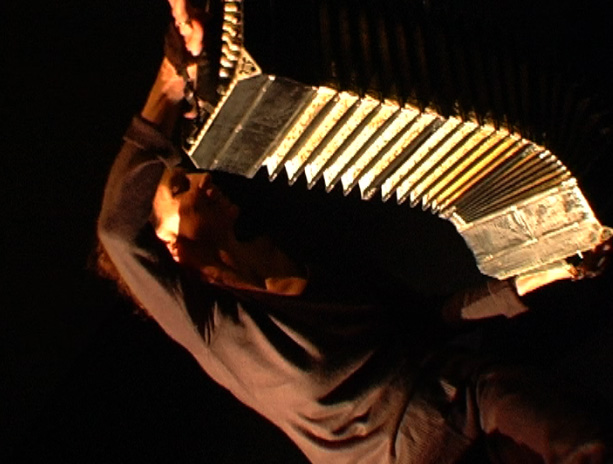|
UKIYO
(Moveable
World)
 .
. .
.


Caroline
Wilkins as Instrumentwoman.(c) DAP-Lab, 2009
Cinematic movement character studies by Johannes Birringer
Notes
on the creation of interactive audiophonic and amplificational design
by
Michèle Danjoux, Johannes Birringer, Caroline Wilkins
03/10/2009
I should very much like to see
the research/writings Caroline has been doing on the 'Zaum/Saum', to
understand better the way our thought processes are developing in order
to further inform the designs I am working on for the 'instrumentwoman'.
The term 'Instrumentwoman' was inspired by Barthes and his writings
on the relationship between woman and garment and then more specifically
on the idea of the hair as 'promised garment'. I saw the Bandoneon as
very much a 'promised garment' or extension of Caroline... or is it
that Caroline is an extension of the instrument? She seems fused, inseparable
and the bandoneon is some weight and yet she makes working with it look
effortless! Actually, I was totally amazed as I spent several hours
intricately studying the Bandoneon at the weight you lift and create
such strong and controlled sound from...I could barely lift, it felt
like a 'bullworker', no wonder Caroline's arms are so beautifully toned.
Anyway, to say a little on design and of becoming instrument, I am hoping
to somehow integrate design features as well as colour and fabrication
of the Bandoneon into my garment ideas for 'instrumentwoman'. I would
love it if for instance when you lift your arm to create the Sun God
image that you have a cream leather diamond shaped gusset under you
arm which has the same construction and appearance as the cream leather
gussets of the Bandoneon... I think your garment has to be about design
detail/attention to detail, beautiful and intricate detail. I think
you need to echo the colours of the Bandoneon, so black, gold and cream
(maybe also some silver tips). The proportions of colour I am not sure
of yet, whether to mimick Bandoneon or almost invert so that you are
more cream and gold, less black...still thinking of overall effect.
I would like ideally to have some type of pleating or concertina/opening
out effect but that needs time to work out and everything needs to be
sympathetic to your movement.
I am thinking of gold and cream leather and perhaps a black neoprene
(wetsuit fabric)... Presently I am designing neat fitted jacket shapes
but that might change. I look at the small sketches you made, Caroline,
of the woman and Bandoneon and would love to be more extreme and extravagant
with the fusion of shapes and forms... I worry however that such shapes
would be awkward to move in and unsympatheic to your own movement plans;
lying down and on an up/down axis. So I wonder had you also considered
performing without your Bandoneon but in a dress totally inspired in
its creation by you and the Bandoneon? Maybe it could emit sound like
an instrument, sound sampled from the Bandoneon but now played differently?
Of course I would need technical help to know how to create such a sound
emitting garment... It's a thought.
Let us hear any thougts you have on how you see garments working with
you, the Bandoneon, your research and proposed movement.
(Michèle Danjoux)
03/09//2009
Caroline's excellent notes and
observations take us further. Some of these notes go back to our rehearsal,
others to her own research, and her beginning to interpret the music-theatre
potentials of the scenes involving the audiophonic/kinaesonic characters..
I believe Michèle has come up with some very strong design sketches
for a dress/suit Caroline might wear that, to an extent, incorporates
or echoes the golden & leather "Saum" (linings)/"Zaum"
(poetry) of the bandoneon into the black fabric.
Caroline's research on "Zaum" (the transrational poetry) is
inspiring,
A nd yes, i was quite aware of the resonances between "Sonnenschein",
the SSR revolution which I gathered from the brief excerpts i was able
to read in ther summer of Christian Kracht's book which had not appeared
yet in print, and the engineering research Imade on 1910/1920 revolutionary
Russia, on futurism. And the fictive "names" I picked for
"scene" titles, such as "Kruchonykh", were deliberately
meant to refer, subliminally, to the futurist opera Victory over
the Sun.......
The zaum poetry of one liners
interested me as well as a kind of code / digital language -so, to answer
your question - yes, indeed, in the Sonnenschein book, now available,
there are two or three small chapters that function as flashbacks. The
Parteikommissär, whose name is not mentioned in the book, who is
nameless, was raised in East Afrika, in an area called Chongoni, and
he belonged to the tribe of the Chiwa. He was then trained in Swiss
schools that the revolution had opened in East Africa, and he was prepared
to become an officer in the revolutionary army, His childhood language
was Chichewa, but now he also speaks Swiss dialect (German, French),
and persumably slavic or russian languages as he also moved between
the SSR lands (Swiss Soviet Republic);
following your poem citation, Ithen looked for Chichewa words in the
Sonnenschein book, and there are none, except two passages:
Usiku dzulo.
Tikuoneni Maria wa tschaulele tschodzadzae
Maria ojera amaji a mulungu mutipemfere ife
Tsopano ndi pa ntawi sosata
(this, strangely, is a Catholic
prayer:, and we all grow up with it:
Heilige Maria Mutter Gottes, bitte für uns Sünder, jetzt und
in der Stunde unseres Todes, Amen.
The only other one-line words I find are at the end of the book, when
the war has been at its worst, and the African Kommissär survived
bombardment inside the Swiss mountain Réduit, and then decides
to return to Africa, taking a ship.
here is the passage:
Unter einem brennend blauen Himmel näherten wir uns endlich der
von Skorpionen befallenen Küste Somalilands.
Ein Delphinschwarm begleitete unser Schiff.
Vögel waren dort, Bambo, Vögel, das Blut der Chiwa sang in
unseren Adern.
Ndafika. Ndakondwa.
Und die blauen Augen unserer Revolution brannten mit der notwendigen
Grausamkeit.
As
you pointed out "zaum" is a kind of onomatopoeia, and "Ndafika.
Ndakondwa." could be names for birds or birdcalls
I like your suggestion very much: <<Should this character 'sound'
the text as a counterpoint to different, 'silent' gestures of the bandoneon?
(ie. air button depressed in order to allow the bellows to move 'silently',
when in fact the air sound is audible.) >> yes, we have to try
and find a way to do this
(Johannes Birringer)
03/8/2009
T he test rehearsal was very fruitful, helping me to develop ideas and
thoughts on my character, Kruchonykha, based on a Russian poet / musician
who was part of the Futurist movement. I enclose some notes made after
the rehearsal:
this character 'has a weakness for the people and utopian visions, floats
underwater' (original suggestions), is dreamy.We explore slow,liquid
movements/gestures made with the instrument (bandoneon).
Kruchonykha wrote an opera entitled 'Victory over the sun' (curious
parallel with the title of one of the working projects: 'Ich werde hier
sein im Sonnenschein') together with Malevich and Matyushin. He invented
a poetry called 'zaum' ( za = beyond, um = mind). One example of a poem:
ika mina ni
sinu ksi
iamakh alik
zel
(note: the vowel 'i' is very present in this extract. Research other
'zaum' poetry).
Is there a link between this sound poetry and the East african languages
/ birdsong mentioned in the book ' Ich werde..' by Christian Kracht?
Should this character 'sound' the text as a counterpoint to different,
'silent' gestures of the bandoneon? (ie. air button depressed in order
to allow the bellows to move 'silently', when in fact the air sound
is audible.)
I presented graphic sketches of body/instrumental movements. Other developments
of this manifested themselves during rehearsal, the instrument encircling
my head whilst lying on the floor,(sun image, mexican goddess?)or over
the knees whilst sitting on the floor.
It would be good to try amplifying the instrument with a contact microphone
when it produces air sounds only.
A contrast to Kruchonykhas' slow movements are those linked to abrupt,
mechanical operations, such as seen in automata figures /machines. These
movements/gestures are short, energetic, repetitive, punctuated by a
sudden stillness as if interrupted. They generate percussive noises,
squeaks, sudden tones, reminiscent of the 'Noise Orchestra' invented
by the Russian Futurists. The bandoneon is standing on its end and 'operated'
from the top. Should we suspend it like a marionette during part of
the performance?
(Caroline Wilkins)
For
the development of the choreographic installation and its interactive
images, go to the February 2009 workshop images:
NEXT
PAGE
This
research project is funded by a PM12 Connect/British Council Grant and
a RDF (Brunel University) grant.
dance
tech network site
of Ukiyo project
All
photos (c) DAP-Lab
a
new project created in a research collaboration between DAP-Lab and
Keio University / Inetdance Japan
all
images from the new rehearsals and software design devopment at DAP
Lab Studio (c) 2008 DAP Lab & Keio University/ inetdance
Further
notes on design and performance concepts are published on this site.
click
here
(c)
dap 2007-08
Project
directors: Johannes Birringer & Michèle Danjoux
Brunel
University, West London
|
Design And Performance Lab
 .
.
.
.
